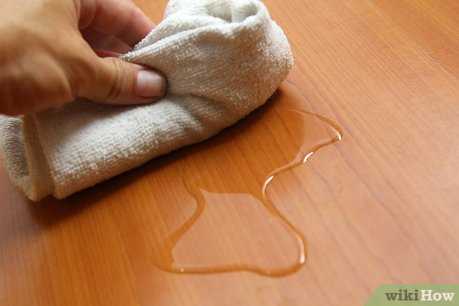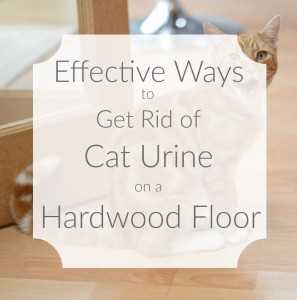



Using a mixture of white vinegar and water in equal parts can effectively tackle the aftermath of my little accidents. Apply the solution to a cloth, gently dab the affected area, and allow it to sit for a few minutes. This simple blend neutralizes odors and helps lift stains without harming the wood.
After treating the spot with vinegar, using a mild dish soap mixed with warm water can provide an extra layer of assistance. A soft cloth or sponge dampened with this solution allows for gentle scrubbing, ensuring that no residue remains. Rinse with clean water and dry thoroughly to prevent any moisture damage.
Enzymatic cleaners specifically designed for pet messes are also an excellent choice. These products break down the components of the stain, effectively eliminating both the mark and the lingering scent. Always follow the manufacturer’s instructions for optimal results.
Lastly, to restore the shine and protect the wood, consider applying a suitable wood polish once everything is dry. This helps maintain the surface’s integrity while leaving it looking fresh and well-cared-for.
Identifying the Urine Spot on Hardwood Floors
Look for yellow stains or discoloration on the surface. These are often more visible in certain lighting. Utilize your nose; a distinct odor can help pinpoint the exact area. A UV flashlight can reveal hidden spots not easily seen by the naked eye.
Checking the Grain
Inspect the wood grain carefully. Stains may settle into the grooves, making them harder to detect. Pay attention to any areas that feel sticky or tacky, as this can indicate the presence of moisture.
Using the Right Tools
A clean cloth or paper towel can help absorb any visible liquid and reveal the underlying color of the floor. If moisture is present, it may darken the wood, further indicating the location of the spot.
Don’t forget to check corners and under furniture, as those places can easily be overlooked. A thorough examination ensures a successful cleanup effort.
Gathering Necessary Cleaning Supplies

Start with paper towels or absorbent cloths for blotting. These will help soak up the liquid quickly. A spray bottle is handy for mixing solutions or applying cleaning agents directly to the area.
For the cleaning solution, consider using a mixture of water and white vinegar. This combination neutralizes odors effectively. Alternatively, enzymatic cleaners designed for pet messes can break down organic materials, making them an excellent choice.
Additional Tools

A soft-bristle brush can gently scrub the affected area without damaging the finish. A bucket will be useful for mixing larger quantities of cleaning agents. Finally, gloves protect hands from harsh chemicals and odors.
Preparing the Area for Cleaning
Clear the space of any furniture or items that may obstruct access to the affected area. This ensures a thorough approach without distractions. If possible, ventilate the room by opening windows, as fresh air will help eliminate odors during the process.
Before tackling the stain, assess the flooring type to determine the best technique for care. Certain hardwood finishes may react differently to cleaning solutions, so being aware of this will guide your choices.
For stubborn spots, consider placing a towel or cloth over the area after applying your chosen cleaning solution, allowing it to absorb for a while. This method can enhance the effectiveness of the cleaning agents used.
If additional tools are needed, the best pressure washer extension pole can be beneficial for reaching high or difficult areas in your home.
Also, ensure that any pets are kept away from the area during the cleaning process to prevent them from interfering or coming into contact with harsh substances.
Lastly, while you’re in the mood for cleaning, consider checking out the best cat food for old skinny cats to keep your feline friends happy and healthy.
Applying Cleaning Solutions to the Stain
To tackle the discoloration effectively, select a cleaning solution that targets the odors and stains. Vinegar and baking soda work wonders. Mix equal parts of white vinegar and water in a spray bottle.
Spray the mixture generously over the affected area. Allow it to penetrate the surface for about 5 to 10 minutes. This step helps to break down the particles causing the unpleasant smell.
Next, sprinkle baking soda directly onto the damp area. This will aid in absorbing any remaining moisture and neutralizing odors. Let it sit for several hours or overnight for optimal results.
After the waiting period, vacuum up the baking soda. If any stain persists, consider applying an enzymatic cleaner specifically designed for organic stains. Follow the instructions on the label closely to achieve the best outcome.
Once the stain appears to be gone, wipe the area with a clean, damp cloth to remove any residue from the cleaning products. Dry the spot thoroughly with a towel to prevent water damage.
Finally, monitor the area for any signs of lingering odor. If necessary, repeat the process until the scent and appearance meet expectations.
Using Proper Techniques to Wipe and Rinse
For optimal results, blot the affected area with a clean cloth, applying gentle pressure. This absorbs liquid without pushing it deeper into the surface. Use a circular motion to lift any remaining residue effectively.
Rinsing the Area
After wiping, it’s crucial to rinse the spot. Dampen a fresh cloth with plain water and gently wipe the area again, removing any cleaning solution. This prevents residue buildup, which might attract dirt over time.
Drying the Surface
Once rinsed, dry the location quickly with a soft towel. Ensure no moisture lingers, as this could harm the wood. For extra assurance, leave a fan on or open windows to promote airflow and speed up the drying process.
| Technique | Description |
|---|---|
| Blotting | Use a clean cloth to absorb liquid; avoid rubbing. |
| Rinsing | Dampen a cloth with water; wipe to remove residue. |
| Drying | Use a soft towel; ensure no moisture remains. |
Deodorizing the Affected Area
For neutralizing odors, a mixture of equal parts water and white vinegar works wonders. Spray the solution on the spot and allow it to sit for about 5-10 minutes to penetrate deeply into the wood. Vinegar’s acidity helps break down lingering particles, eliminating unpleasant smells effectively.
Using Baking Soda
After applying the vinegar solution, sprinkle a generous layer of baking soda over the area. This natural deodorizer absorbs any remaining odors. Let it sit for several hours or overnight if possible. Once it’s had time to work, vacuum up the baking soda thoroughly.
Essential Oils for Freshness
To leave a pleasant scent, consider adding a few drops of essential oil, like lavender or lemon, to the cleaning solution. This not only freshens the space but also provides a calming aroma, making the area more inviting.
Preventing Future Accidents on Hardwood Floors
Establish a designated bathroom area for meow moments. Use litter boxes with different types of litter to find the most appealing option for your feline. Regularly clean and maintain these boxes to encourage usage.
Consider using pheromone diffusers or sprays that promote calmness and reduce stress. A relaxed environment minimizes the likelihood of unexpected mishaps.
Regularly schedule playtime and exercise sessions. A tired kitty is less likely to mark territory or have accidents out of boredom.
Implement a consistent feeding schedule. Predictable meal times contribute to regular bathroom habits, making accidents less likely.
Monitor any changes in behavior that may indicate health issues. Frequent accidents can signal underlying medical concerns; a vet visit may be necessary.
Keep an eye on your cat’s preferences for surfaces. If the wood feels uncomfortable, providing alternative comfortable spaces can redirect their preferences.
Lastly, ensure that any new furniture or decor does not create stress or anxiety. A stable environment fosters good habits and helps maintain cleanliness.







